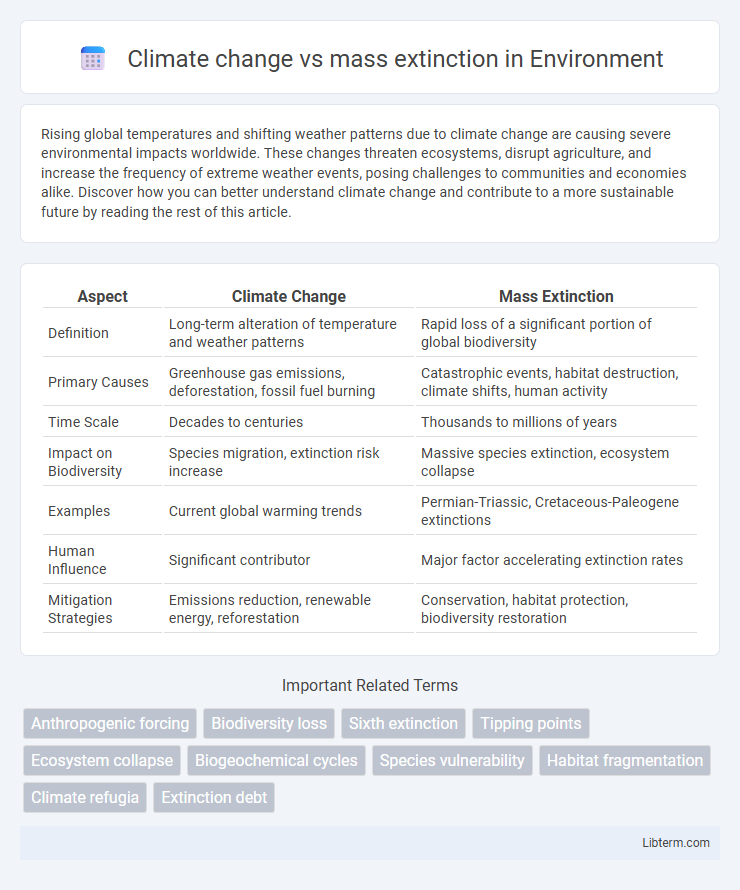Rising global temperatures and shifting weather patterns due to climate change are causing severe environmental impacts worldwide. These changes threaten ecosystems, disrupt agriculture, and increase the frequency of extreme weather events, posing challenges to communities and economies alike. Discover how you can better understand climate change and contribute to a more sustainable future by reading the rest of this article.
Table of Comparison
| Aspect | Climate Change | Mass Extinction |
|---|---|---|
| Definition | Long-term alteration of temperature and weather patterns | Rapid loss of a significant portion of global biodiversity |
| Primary Causes | Greenhouse gas emissions, deforestation, fossil fuel burning | Catastrophic events, habitat destruction, climate shifts, human activity |
| Time Scale | Decades to centuries | Thousands to millions of years |
| Impact on Biodiversity | Species migration, extinction risk increase | Massive species extinction, ecosystem collapse |
| Examples | Current global warming trends | Permian-Triassic, Cretaceous-Paleogene extinctions |
| Human Influence | Significant contributor | Major factor accelerating extinction rates |
| Mitigation Strategies | Emissions reduction, renewable energy, reforestation | Conservation, habitat protection, biodiversity restoration |
Understanding Climate Change: Causes and Impact
Climate change results primarily from increased greenhouse gas emissions such as carbon dioxide and methane, driven by fossil fuel combustion, deforestation, and industrial activities. These changes disrupt global temperature patterns, leading to habitat loss, ocean acidification, and extreme weather events that threaten biodiversity. The accelerated pace of climate change significantly raises the risk of mass extinction by altering ecosystems faster than many species can adapt.
Defining Mass Extinction Events
Mass extinction events are characterized by a dramatic and widespread loss of biodiversity, where a significant percentage of species vanish within a relatively short geological timeframe. Historically, five major mass extinctions, such as the Permian-Triassic and Cretaceous-Paleogene events, have profoundly reshaped Earth's ecosystems. Current climate change poses a significant threat that some scientists argue could trigger a sixth mass extinction by accelerating habitat loss, species extinction rates, and ecosystem disruption.
Historical Mass Extinctions: Lessons from the Past
Historical mass extinctions like the Permian-Triassic, which wiped out over 90% of marine species, offer critical insights into the potential impacts of current climate change driven by greenhouse gas emissions. Rapid shifts in global temperature, ocean acidification, and habitat loss during these events highlight the vulnerability of biodiversity to unprecedented environmental stressors. Understanding these patterns helps predict the risks modern ecosystems face, emphasizing the urgent need for climate action to prevent a similar biodiversity collapse.
The Link Between Climate Change and Biodiversity Loss
Climate change accelerates biodiversity loss by altering habitats, disrupting migration patterns, and causing species extinction at unprecedented rates. Rising temperatures and shifting weather patterns undermine ecosystem stability, reducing the resilience of flora and fauna. This linkage between climate change and mass extinction threatens global ecological balance and human survival.
Human Activity: Accelerating Climate and Extinction Risks
Human activity significantly accelerates climate change through the release of greenhouse gases, intensifying global warming and disrupting ecosystems. This rapid environmental alteration heightens extinction risks by destroying habitats, altering food sources, and increasing species vulnerability. Scientific data links deforestation, fossil fuel combustion, and industrial pollution directly to both rising temperatures and unprecedented biodiversity loss rates.
Comparing Current Trends: 21st Century vs Ancient Extinctions
Current climate change accelerates global temperatures at an unprecedented rate, surpassing many ancient extinction events like the Permian and Triassic periods, which unfolded over thousands to millions of years. Unlike past extinctions primarily triggered by volcanic activity or asteroid impacts, the 21st century's mass extinction drivers include rapid habitat loss, ocean acidification, and human-induced greenhouse gas emissions. Contemporary biodiversity loss rates are estimated to be 100 to 1,000 times higher than natural background extinction levels, raising concerns about ecosystem collapse similar to past mass extinction thresholds.
Key Species at Risk: Indicators of Ecological Collapse
Key species at risk from climate change, such as coral reefs, polar bears, and amphibians, serve as critical indicators of ecological collapse due to their sensitivity to temperature fluctuations and habitat loss. Rapid declines in these species' populations signal disruptions in ecosystem services, biodiversity loss, and cascading effects across food webs. Monitoring these vulnerable taxa provides essential data for predicting mass extinction events and implementing urgent conservation strategies.
Potential Consequences for Global Ecosystems
Climate change accelerates habitat loss, disrupting biodiversity and increasing the risk of species extinction, thereby threatening ecosystem stability. Rising temperatures and altered precipitation patterns reduce the resilience of coral reefs, rainforests, and Arctic habitats, critical for global carbon cycling and oxygen production. Unchecked climate shifts could trigger a mass extinction event, leading to irreversible damage to ecosystem services essential for human survival and planetary health.
Mitigation Strategies: Preventing Climate-Driven Extinction
Mitigation strategies targeting climate-driven extinction emphasize reducing greenhouse gas emissions through renewable energy adoption, carbon capture technologies, and reforestation. Protecting and restoring natural habitats enhances ecosystem resilience, allowing species to adapt to changing conditions. Implementing policies that support sustainable land use and biodiversity conservation is crucial for preventing irreversible species loss linked to climate change.
The Future: Can Humanity Reverse the Tide?
Humanity's ability to reverse climate change hinges on rapid decarbonization, widespread adoption of renewable energy, and large-scale ecosystem restoration to prevent a mass extinction event. Advances in carbon capture technologies, alongside global climate policies aligned with the Paris Agreement goals, offer pathways to mitigate rising temperatures and biodiversity loss. Sustained international cooperation and innovation in sustainable practices are critical for stabilizing ecosystems and securing a viable future for diverse species.
Climate change Infographic

 libterm.com
libterm.com